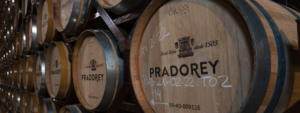You’ve probably heard someone order a “Roble” when referring to a red wine. And chances are, you’ve also wondered what makes this type of wine special and where its name comes from. Whatever the case, one thing is certain: Roble wines have revolutionized Spanish winemaking, especially in Ribera del Duero, the region where this category was born. Here, we’ll tell you about their main characteristics and why they’ve become so successful. Get ready, because we’re about to surprise you.
A Roble is a young wine with a light touch of oak aging. Under this concept, it could be considered a “semi-Crianza,” which explains many of its virtues: it retains the appeal of young wines but also has a hint of oak that makes it smoother and slightly more complex.
There is no consensus on the minimum time a young wine must spend in barrels to qualify as a “Roble,” but the general standard, adopted for example by the Regulatory Council of the Ribera del Duero Designation of Origin (the first to define this term), is at least three months. However, barrel aging can vary between wineries, with Roble wines on the market aged for 3, 6, or 9 months. Naturally, the longer the aging, the closer it resembles a Crianza and less like a young wine.

In the past, it was common to use young wines from the current harvest to season new barrels before using them for aging more prestigious wines. This wine would typically remain in the barrel for 3 to 6 months.
In 1997, the winemaking team at PRADOREY realized that these wines, which were then blended back into the young wine batch, had a unique personality that deserved recognition.
As we explained earlier, they displayed the freshness and typicity of young wines with subtle hints reminiscent of aged wines, resulting in a wine that was easy to drink, versatile for food pairings, and suitable for various consumption moments.
A Roble wine is perfect as an aperitif, with a meal, or even during a relaxed moment of reading or watching your favorite movie or series at home.
The climatic conditions of Ribera del Duero once made its young wines harsh and astringent, while Crianzas—perhaps the most characteristic wines of the region—were often prohibitively expensive due to the rising popularity of the Ribera del Duero.
Roble wines bridged the gap. Their barrel aging softened the harshness of young wines, creating a red wine that was easy to drink. At the same time, they offered fans of Ribera del Duero Crianzas a wine reminiscent of them but at a much more accessible price.
In no time, the Roble category dominated Ribera del Duero’s sales across all distribution channels in Spain, achieving a leadership position within the denomination of origin. It changed the region forever—not just in winemaking practices but also by democratizing its wines, popularizing them, and accelerating their global expansion.
Back in 1982, Ribera del Duero had only 6 wineries, compared to nearly 300 today. In 1997, when the first Roble was made, there were only 85.
The Roble category has faced criticism, with some pointing out—sometimes rightly so—that wineries have overused oak in these wines, making them more like Crianzas than young wines. At PRADOREY, we remain true to the original purpose of this wine: improving Ribera del Duero’s young wines. That’s why we always strive to let the grape’s character shine through.
As mentioned earlier, PRADOREY invented the Roble category in 1997. While our primary focus remains on producing terroir-driven wines, we areproud to have contributed to Ribera del Duero’s history.
In 2015, during our ongoing enological revolution, we decided to reinvent everything and return to the original idea behind this wine. That’s why our classic PRADOREY Roble has evolved into PRADOREY ORIGEN.
We opted for spontaneous fermentation with indigenous yeast, aqueous-phase extractions, shorter barrel aging periods using second- and third-year barrels to avoid the aggressive oakiness that became trendy for a time, and aging in centuries-old clay amphorae. This approach has proven successful. Not only has our ORIGEN enjoyed a renaissance in sales, but it has also received awards and high ratings from various wine critics since its launch.
After exploring its characteristics, origins, and peculiarities, all that’s left is for you to try it if you haven’t already. You’ll be surprised by its intense red color with purple hues, its natural, penetrating aroma, and above all, its easy drinkability and versatility for pairing with meals, appetizers, or celebrations with friends, family, and loved ones.
If you’d like to learn more about PRADOREY ORIGEN, click here.
¿Te ha gustado este artículo?